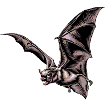Museum, University of Nebraska State

University of Nebraska State Museum: Mammalogy Papers
Document Type
Article
Date of this Version
2-1-1971
Citation
Journal of Mammalogy (February 1971) 52(1).
Abstract
For more than 100 years, the red fruit-eating bat, Stenoderma rufum Desmarest, 1820, was known only by a specimen of unknown geographic provenience. Anthony ( 1918, 1925) rediscovered Stenoderma in Puerto Rican cave deposits, but the first living specimens to be reported since the original description were taken on St. John in the Virgin Islands (Hall and Bee, 1960). Subsequently, Tamsitt and Valdivieso (1966) recorded living representatives from Puerto Rico-from a population later named and described as a distinctive subspecies, Stenoderma rufum darioi, by Hall and Tamsitt (1968). The latter authors also reported a specimen of S. r. rufum from St. Thomas. Choate and Birney (1968), based on their study of Recent and sub-fossil material, named and described a third subspecies, Stenoderma rufum anthonyi, from cave deposits in Puerto Rico. The only other recent references in the literature to Stenoderma are those of Tamsitt and Fox (1970), who recorded a listrophorid mite from a specimen from Puerto Rico, and two papers on electrophoretic properties of hemoglobin (Valdivieso et al., 1969, and Tamsitt and Valdivieso, 1969); S. rufum remains one of the least known of North American phyllostomatids. In the period 17-20 July 1969, one of us (Baker) took 28 specimens, 17 males and 11 females (housed in the collections at Texas Tech University, TT 8858-84, 9830), in mist nets set near the El Verde Research Station, Laquillo National Forest, Puerto Rico. These, along with a male and female in the Museum of Natural History at The University of Kansas (KU 114009-10) from the same place that were earlier reported by Hall and Tamsitt (op. cit.), form the basis for the present report on variation in S. rufum from that island. Also, we have used in our comparisons two of the three specimens from St. John (KU 74030-31) reported by Hall and Bee (op. cit.) as well as the holotype ofS. r. anthonyi.


Comments
Copyright 1971, American Society of Mammalogists. Used by permission.